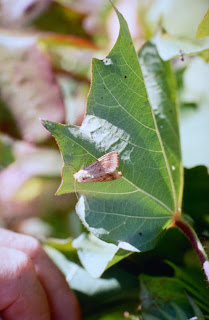Grasshopper: Sporadic Pest of Seedling Cotton
Ron Smith
Grasshoppers have been a sporadic pest of seedling cotton for 10 or more years. This problem emerged as a result of the conservation movement to reduced tillage. Certain seasons seem to be worse than others and 2018 has resulted in greater concern than more recent years. Growers reported observing high numbers of adult grasshoppers during harvest season in fall 2017. Overwintering populations are influenced by environmental conditions. Rainfall is likely more important than temperatures. Dry winters are favorable for grasshopper population since they overwinter as eggs in the soil. Grasshopper problems are sporadic and almost always associated with reduced tillage fields.
The primary grasshopper that damages cotton is the differential species which also overwinters as eggs in the soil. Eggs hatch from late March throughout April, May and June as soil temperatures rise and spring rains occur. The first nymph to leave the egg pod makes a tunnel from the pod to the soil surface through which the succeeding nymphs emerge. Nymphs feed and grow for 35 to 50 days before becoming adults which can then fly. The nymphs or immatures can only jump. Their development proceeds most rapidly when the weather is warm but not too wet. Mature grasshoppers mate and continue feeding on plants About 2 weeks later, females begin to deposit clusters of eggs in the soil. Soil particles are glued together around the eggs to form a protective pod Each pod may have 25-150 eggs. Most grasshopper species only complete one generation per year.
In fields with historical grasshopper problems,
growers may want to take a more preventative approach by adding a grasshopper
insecticide to their burn down herbicide. Since not all grasshoppers emerge
from the egg stage at the same time, a long residual IGR (insect growth
regulator) insecticide could also be utilized. Dimlin has proven to be a good management
tool for grasshoppers. It has extended residual that provides good control of
immature grasshoppers but will not control adults.
There are no established thresholds for grasshoppers in
cotton and will likely never be since their feeding habits are so
unpredictable. Some fields and some years may have grasshopper damage while other
fields and years have the same level of grasshoppers but no damage.
Preventative insecticide applications for grasshoppers are a judgment call. When
grasshoppers are observed, and cotton is in the susceptible stage, treatments
can be based on the risk level that an individual grower is willing to take.
Grasshopper problems are greater in lighter soils or soils
with higher sand content. Damage often occurs in the same fields or farms from
year to year. Grasshopper damage as stated is unpredictable but can potentially
threaten a stand. Grasshoppers may feed on foliage, but most economic damage
occurs when grasshoppers feed on the main stem of emerging (in the crook or
cracking stage) seedlings. In some cases, grasshoppers may completely sever the
stem, but more often they will chew partially through the stem weakening the
plant which will fall over at the feeding site.
Most all cotton insecticides will control immature
grasshoppers when applied at a low labelled rate. Later into the spring, adult
grasshoppers are very difficult to control with any insecticide, even at a high
labelled rate. Acephate (Orthene) at 0.6 lb. active per acre has proven to be
the most effective grower treatment for adult grasshoppers.









